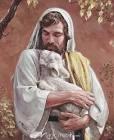
There are may images used to describe Jesus. The Apocalypse depicts him as "a lamb standing as though it had been slaughtered" (Apoc. 5:6). Lambs were sacrificial offerings for sin, so Jesus takes their place. He alone can open the seven seals and make clear the plan of God for humanity (Apoc. 5). In today’s reading this lamb is enthroned and worshipped in the heavenly court, where those who have suffered are now free from all earthly troubles, under the protection of the lamb who is also their shepherd. At the end of the Apocalypse the lamb is married to the bride, the church or people of God (Apoc. 19:7-8).
In the gospel the lamb has again become the shepherd, who cares for his sheep to the extent that he lays down his life for them. The good shepherd is one who knows each animal by name. The leadership of Christ is one that does not dominate but invites each person to follow him, so that they may be nourished and develop to reach their full potential. It is significant that Jesus told Peter to feed His lambs and his sheep (John 21:15-19). He was to imitate his master in his care for them; this would be a marked contrast to the government of the Roman Empire, which led by force of arms, or the Jewish priesthood, which was often corrupt and self-serving.
The New Testament has many ways of drawing a portrait of Jesus, who is Lord and King, so that we may get to know him better and love him more deeply.
The Lord is my shepherd;
there is nothing I shall want.
Fresh and green are the pastures
where he gives me repose.
(Psalm 22)